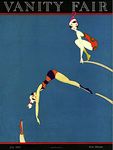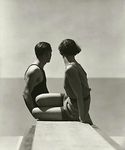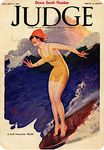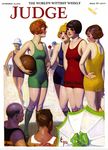Styling by the Sea 140 Years of Fashion on Galveston's Beaches - The Bryan Museum
←
→
Page content transcription
If your browser does not render page correctly, please read the page content below
Styling by the Sea
140 Years of Fashion on Galveston’s Beaches
Bathing Suit Fashions in the 1920s
As in our own time, styles did not change overnight from one
day to the next between the 1910s and the 1920s. Bathing suits
popular during the second decade of the 20th-century disappeared in
the 1920s by degrees as they were worn out or their owners decided
to replace them with new, up-to-date designs. The photo to the right,
of contestants in Galveston’s first Beach Revue in 1920 shows the
variety of swimwear styles popular at the time. The exuberance of
the 1920s was manifested in the array of colors and applied
decorative details that abounded on bathing suits, especially at the 1920 Contestants in Galveston’s
beginning of the decade. First Beach Revue
Image: Galveston Historical
Foundation
Despite increasingly liberal attitudes in the 1920s the battle to
liberate women, and to a lesser degree men, from conservative legislation that restricted how much of
their arms and legs they could display on the beach was far from won. As noted in an article that
appears on the Rare Historical Photos website, “In the early 1900s, modesty laws were very strict and
required most women to wear long one piece garments as well as stockings. Even the men without
shirts were banned from the beaches in Atlantic City, New
Jersey, the reason being that the city didn’t want “gorillas on
our beaches’.” As seen in the photos presented to the left
police were charged with enforcing laws, and would arrest
offenders if they failed to comply with restrictions.
Eventually, changing mores, and pressure from the
public, resulted in the repeal of outmoded modesty laws. At
the same time a long held belief that bathing at the sea was
mainly for health purposes gave way to an acknowledgment of
the fact that it was truly a leisure activity. People went to the
shore to have fun.
The first alteration in bathing suit design was related
with the disappearance of the arms on swimwear. This was
followed by a drop in necklines from the throat to the top of the
bosom. Finally the length of the suits grew shorter, rising from
the knee to mid-thigh.
1Parasols, Head Coverings, and Shoes
In the 1920s the parasol became an indispensible accessory for
fashionable women at American coastal resorts. Although elegant fabric parasols
were used commonly in the 19th-century, to shield ladies from the effects of the
sun, a type new to America, made from bamboo and paper or silk, and imported
from the Far East, came into vogue at this time. These parasols were affordable,
colorful, and versatile. Available in a range of sizes, they were adorned with
paintings of flowers, butterflies, peacocks, mythological beasts, and geometric
patterns. They appeared everywhere; in fashion photographs, on posters and
magazine covers, in the hands of silent film stars, and in innumerable casual snap
shots.
The function of the parasol began to change during the 1920s. Rather
than serving primarily as sun shades, their role became increasingly decorative.
This evolution was an outgrowth of a trend that is supposed to have begun with
the chic, French clothing designer, Coco Chanel. Always on the vanguard of
style, Chanel popularized tanning among women. In sharp contrast to the past
when a complexion untouched by the sun was viewed as a symbol of upper-class
refinement, the warm, bronze skin tones that gained acceptance among both men
and women in the 1920s became a mark of the leisure class that partook of
healthy outdoor athletic activities like golf and tennis. Concurrent with the new
attitude toward tans resorts, which had formerly served as playgrounds for
wealthy patrons escaping from cold northern climates during the winter months,
became popular summer destinations for celebrities and wealthy clients.
In the 1920s women traded in the
dowdy mop caps, and other less fashionable
beach hats worn in previous decades for
berets, fitted caps, and the ubiquitous
headscarf. In order to make sure that they
wore their scarves properly to achieve the
most flattering effect, instructions like those
appearing to the right about how to tie them
appeared in publications during the period.
Linea Germanisa, “Hollywood, Scarves, & the
1920s” December 31, 2018 Jalyn Eaton
2The illustrations on this and the previous page
provide evidence that shoes and stockings
continued to be popular on beaches during the
1920s. In the case of stockings they took on
decidedly sexier overtones. Hard as it is to believe
pumps were common as were flat cloth shoes and
foot coverings resembling ballet slippers. Shoes
would remain popular into the 1930s.
Men’s swimwear during the 1920s became lighter due to improved knitting technology.
When wet, however, their wool suits still weighed as much as eight pounds and could sag and
cling with embarrassing results. Modesty was required of men as specified in the "Bathing Suit
Regulations" published on May 17, 1917. According to these laws men's suits had to be worn with
a skirt or have at least a skirt effect and the skirt had to be worn outside of the trunks. The other
alternative available to men was flannel knee pants with a vest and a fly front.
One-piece suits prevailed. Shorts were attached to a tank-like top that covered the legs of
the bathing suits. Swimwear took on a sleeker appearance than the bathing suits worn in the
1910s although they remained sober in terms of color and decoration. Occasionally bathing suits
were “trimmed” in stripes at the bottom edge of the skirt.
As seen in the photograph to the left swimsuits worn by
men and women, especially later in the decade, were essentially
unisex in their styling. They stretched to the contours of the body
as needed. The major difference between them was that the
men’s bathing suits was cut lower on the sides and in the back.
In 1930 the fashion
photographer George Hoyningen-
Huene composed one of his most
famous works, The Divers, which
features a man and a woman
sitting on a diving board facing
away from the camera. This
ageless image captures the essence of this unique moment in
fashion history when unisex style swimwear was in vogue.
The Divers 1930 by George
Hoyningen-Huene
3Sunglasses
Ways to modify the glare of sunlight have existed for
thousands of years. Prehistoric Inuits peoples living in the far
north crafted flat walrus ivory shades to protect their eyes from
the sun, and it is said that the emperor Nero viewed bloody
contests in the Roman Coliseum through the cooling filter
provided emeralds.
Modern, mass-produced sunglasses were marketed for
the first time in 1929. Introduced to the public by a man named Sam Foster they were sold under
the name “Foster Grant” at a Woolworth’s store on the boardwalk in Atlantic City, New Jersey.
Foster’s shades soon became a hot fashion item and an indispensible accessory. Initially adopted
by movie stars and celebrities, sunglasses became a “must have” on America’s beaches. The
original version was unisex and featured round lenses. They retained this shape well into the
1930s.
Four winners of the Splash Sunday
Parade Treasure Island, Galveston,
Texas mid 1920s
Casual “snapshots”, made possible as a result of Kodak’s widely popular Brownie” line of
cameras, provide us with innumerable images of people cavorting by the side of the sea. Except
for their swimwear they look to beach goers today. They convey a casual ease and a sense of
fun.
Magazines Covers in the 1920s
Illustrations related to the beach and summer, which appeared on magazine covers in the
1920s, present us with intriguing glimpses of male/female relationships at the time - at least in the
way publishers chose to present them. These images, created by talented, perceptive artists, are
often funny, tongue in cheek, commentaries on human foibles that also happen to provide us with
pictures of sleek new beach fashions for women. Judge magazine (1881 – 1947), a sophisticated
satirical weekly that included articles about current events, society, politics and culture led the way
with a large number of issues that presented illustrations of young women on their summer covers.
4The females presented are almost all beautiful, liberated
sophisticates. They are portrayed as everything from sexy to serious.
Far from being wide-eyed ingénues these women are athletes, vamps,
coquettes, carefree flappers, and in one instance the victim of too much
sun while working on her tan. Their bathing suits are colorful and form-
fitting to show off their great figures, and their shoes, stockings,
headwear, parasols and cloaks/beach towels provide perfect
compliments to their swimwear. They are conscious of their sexual
appeal and the power it gives them.
It is amusing to note that in two of the rare covers where men are
shown as active players on the scene (they are muscular lifeguards),
one from The Saturday Evening Post, and another from Judge, these
males see immediately through the “helpless damsel in distress” ploy women have adopted to get
their attention. The guys know the gals are perfectly capable of taking care of themselves. The
women are not meek, shy, and retiring. They have simply identified something they want (the
men) and they are out to get it. These women are strong competitive fighters. One cover,
Judge’s “Prize Fight” issue of September 1923, shows a woman in a purple bathing suit wearing
boxing gloves who has just decked a man. The caption under the illustration reads “The Wedding
Ring”. It is clear who is in control.
5You can also read



























































